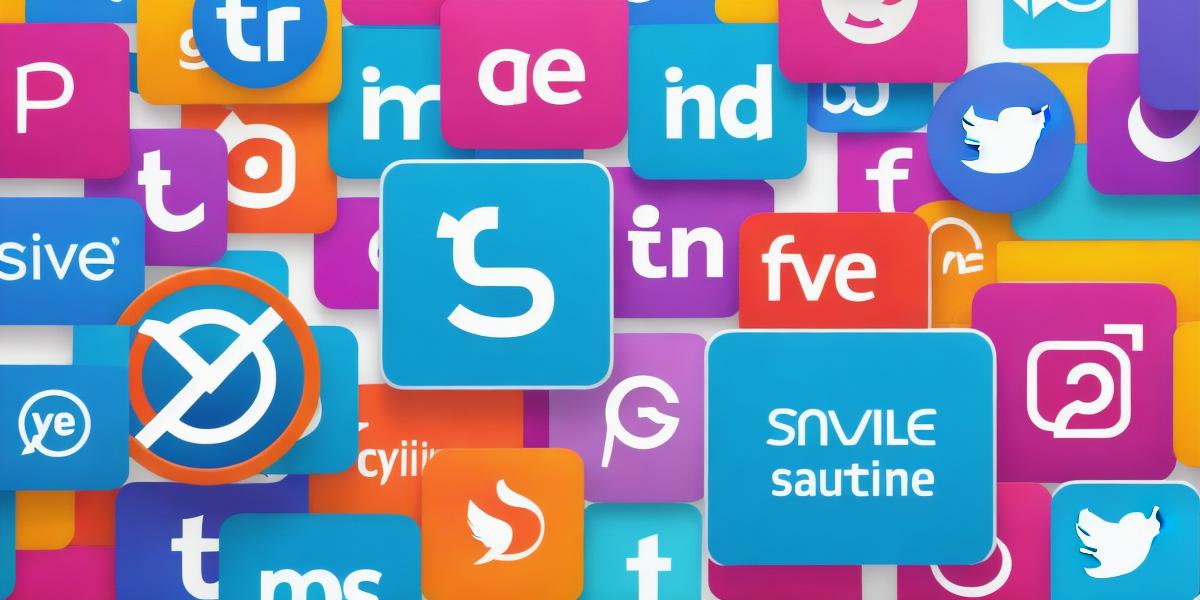Introduction
Digital advertising has become an integral part of modern marketing strategies, providing businesses with a cost-effective and measurable way to reach their target audiences. With the vast array of tools available, it can be overwhelming for marketers to choose which ones to use. In this article, we’ll take a look at 10 common marketing tools used in digital advertising campaigns and explore their benefits and drawbacks.
1. Social Media Advertising
Social media advertising is one of the most popular digital marketing tools, allowing businesses to target specific audiences on platforms such as Facebook, Instagram, Twitter, and LinkedIn. The benefits of social media advertising include its ability to reach a wide audience, targeting specific demographics, and providing real-time analytics for monitoring campaign performance. However, there are also drawbacks to social media advertising, including the potential for ad fatigue and competition for ad space.
Case Study: Dollar Shave Club’s Viral Video Campaign
In 2012, Dollar Shave Club released a hilarious video that went viral on YouTube and sparked a conversation about the company’s subscription-based business model. The video, which featured CEO Michael Dubin delivering a humorous monologue in a bathroom, garnered over 12 million views and helped to catapult Dollar Shave Club into the spotlight.
Social Media Advertising Tips:
- Use eye-catching visuals and creative copy to grab your audience’s attention.
- Target specific demographics to ensure your ads are seen by people who are most likely to be interested in your product or service.
- Utilize retargeting to reach potential customers who have previously interacted with your brand.
2. Search Engine Advertising (SEA)
Search engine advertising, also known as pay-per-click (PPC) advertising, allows businesses to place their ads on search engine results pages (SERPs). This type of advertising is highly targeted, allowing businesses to reach people who are actively searching for products or services related to their industry. The benefits of SEA include its ability to generate immediate traffic and leads, as well as measurable results through real-time analytics. However, there are also drawbacks to SEA, including the potential for high costs for highly competitive keywords.
Case Study: Warby Parker’s Successful SEA Campaign
In 2013, Warby Parker launched a successful SEA campaign that targeted specific long-tail keywords related to eyewear, such as "affordable glasses" and "discounted sunglasses." The campaign resulted in a significant increase in traffic and sales for the company, highlighting the power of targeted advertising.
SEA Tips:

- Conduct thorough keyword research to identify highly relevant and targeted keywords for your business.
- Use ad extensions such as call extensions and location-based targeting to enhance the performance of your ads.
- Utilize A/B testing to optimize your ad copy and landing pages for maximum conversions.
3. Email Marketing
Email marketing is a classic digital marketing tool that allows businesses to communicate with their customers through email campaigns. The benefits of email marketing include its ability to build relationships with customers, increase brand awareness, and drive sales. However, there are also drawbacks to email marketing, including the potential for low open rates and spam filters.
Case Study: Sephora’s Successful Email Campaign
In 2016, Sephora launched a successful email campaign that promoted its new Beauty Insider program, which offered exclusive rewards and discounts to customers. The campaign resulted in a significant increase in sign-ups and sales for the company, highlighting the power of personalized messaging.
Email Marketing Tips:
- Build an email list through lead magnets and other incentives.
- Use personalization techniques such as name tags and product recommendations to increase engagement.
- Segment your email list based on demographics and behavior to ensure your messages are relevant to each subscriber.
4. Content Marketing
Content marketing is a digital marketing strategy that involves creating valuable, relevant, and consistent content to attract and engage a target audience. The benefits of content marketing include its ability to increase brand awareness, establish authority in an industry, and drive sales through lead generation and conversion. However, there are also drawbacks to content marketing, including the time and resources required to create high-quality content.
Case Study: HubSpot’s Successful Content Marketing Campaign
In 2013, HubSpot launched a successful content marketing campaign that targeted small business owners with valuable resources such as blog posts, infographics, and ebooks. The campaign resulted in a significant increase in traffic and leads for the company, highlighting the power of educational content.
Content Marketing Tips:
- Identify your target audience’s pain points and create content that addresses them.
- Use various types of content such as blog posts, videos, and infographics to keep your audience engaged.

- Utilize social media and email marketing to distribute your content and drive traffic to your website.
5. Influencer Marketing
Influencer marketing is a digital marketing strategy that involves partnering with social media influencers or other individuals with a large following to promote products or services. The benefits of influencer marketing include its ability to reach new audiences, increase brand awareness, and drive sales through referral traffic. However, there are also drawbacks to influencer marketing, including the potential for fake followers and low engagement rates.
Case Study: Glossier’s Successful Influencer Marketing Campaign
In 2016, Glossier launched a successful influencer marketing campaign that partnered with popular beauty influencers such as Emily Weiss and Tavi Gevinson to promote its new skincare line. The campaign resulted in a significant increase in sales for the company, highlighting the power of authentic endorsements.
Influencer Marketing Tips:
- Identify influencers who have an engaged following that aligns with your target audience.
- Create compelling content that showcases your product or service and encourages influencers to share it with their followers.
- Use metrics such as engagement rates and conversion rates to measure the success of your influencer marketing campaign.
6. Video Marketing
Video marketing is a digital marketing strategy that involves creating and distributing videos to engage and educate audiences. The benefits of video marketing include its ability to increase brand awareness, drive traffic and sales, and improve SEO through search engine optimization (SEO). However, there are also drawbacks to video marketing, including the potential for low engagement rates and high production costs.
Case Study: Dollar Shave Club’s Successful Video Marketing Campaign
In 2012, Dollar Shave Club released a hilarious video that went viral on YouTube and sparked a conversation about the company’s subscription-based business model. The video, which featured CEO Michael Dubin delivering a humorous monologue in a bathroom, garnered over 12 million views and helped to catapult Dollar Shave Club into the spotlight.
Video Marketing Tips:
- Keep your videos short and engaging to capture the attention of your audience.
- Use humor, emotion, and storytelling to create an emotional connection with your viewers.
- Optimize your videos for SEO by including relevant keywords in your title, description, and tags.
7. Affiliate Marketing
Affiliate marketing is a digital marketing strategy that involves partnering with affiliate marketers or other individuals who promote products or services on behalf of companies. The benefits of affiliate marketing include its ability to reach new audiences, increase brand awareness, and drive sales through referral traffic. However, there are also drawbacks to affiliate marketing, including the potential for low engagement rates and fraudulent activity.
Case Study: Amazon’s Successful Affiliate Marketing Program
Amazon has a successful affiliate marketing program that allows individuals to earn commissions on products sold through their unique affiliate link. The program has generated billions of dollars in revenue for the company, highlighting the power of incentivized partnerships.
Affiliate Marketing Tips:
- Identify affiliate marketers who have an engaged following that aligns with your target audience.
- Create compelling content that showcases your product or service and encourages affiliate marketers to share it with their followers.
- Use metrics such as commission rates and conversion rates to measure the success of your affiliate marketing program.
8. Search Engine Optimization (SEO)
SEO is a digital marketing strategy that involves optimizing website content and structure to improve search engine rankings and drive organic traffic to your site. The benefits of SEO include its ability to increase brand visibility, drive targeted traffic, and improve the ROI of your online presence. However, there are also drawbacks to SEO, including the time and resources required to create high-quality content and follow best practices.
Case Study: Moz’s Successful SEO Campaign
Moz is a leading provider of SEO software and services that has successfully optimized its website for search engines. The company’s website ranks highly in search engine results pages (SERPs) for keywords related to SEO, driving targeted traffic and increasing brand visibility.
SEO Tips:
- Conduct keyword research to identify relevant and high-traffic keywords to target.
- Use on-page optimization techniques such as meta tags, headings, and content structure to improve search engine rankings.
- Build high-quality backlinks from authoritative sources to increase your website’s authority and visibility in SERPs.
In conclusion, there are many digital marketing tools available to businesses looking to promote their products or services online. Each tool has its own benefits and drawbacks, and the most effective strategy will depend on the specific needs and goals of each business. By leveraging these tools in combination with creative content and a strong brand, businesses can drive targeted traffic, increase conversions, and grow their bottom line.




